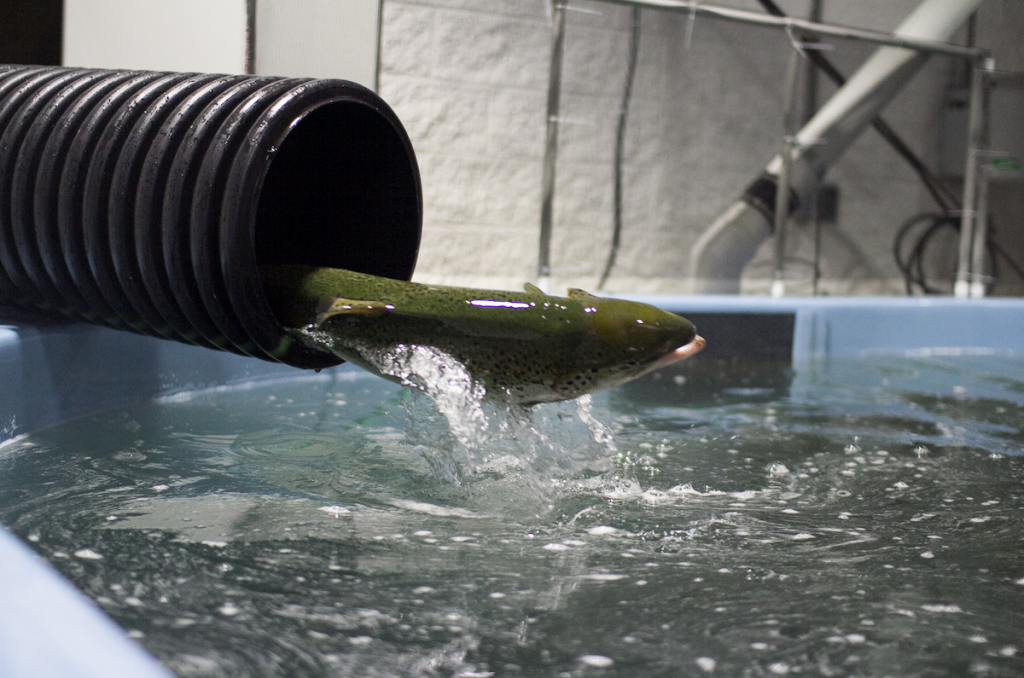
Features
Education
Freshwater
How-to
Management
The purge: Mitigating off-flavor issues
August 13, 2019 By Freshwater Institute
 Purging the fish in a clean system prior to harvest is an effective way to mitigate off-flavor issues in the fish tissue. (Photo credit: The Conservation Fund)
Purging the fish in a clean system prior to harvest is an effective way to mitigate off-flavor issues in the fish tissue. (Photo credit: The Conservation Fund) Common off-flavor compounds, geosmin and 2-methylisoborneal (MIB), produced by bacteria residing in biofilms accumulate in the tissues of RAS-grown fish and create unpalatable earthy or musty flavors. Mitigating off-flavor from the tissues of fish prior to harvest is essential to produce a quality product that consumers will enjoy and purchase again.
Currently, the primary technique for mitigating off-flavor is purging fish in a clean, disinfected system that is well flushed with make-up water. This method is relatively simple, but there are several factors each facility should consider when developing standard operating procedures to ensure fish are off-flavor free and ready for market.
The differing goals of a depuration system compared to those of a production system should be reflected in the design. One consideration is that purging fish will be kept off-feed approaching harvest. Fasting will greatly reduce solids production, which may eliminate the need for mechanical filtration processes, assuming adequate flushing. Fasting will also reduce oxygen demand which could influence sizing of degassing and oxygenation unit processes. However, degassing and oxygenation should be adequate to compensate for high fish respiration upon initial stocking, where oxygen could be rapidly depleted.
Depuration systems should be equipped with reliable monitoring, back-up, and alarming equipment to protect the facility’s investment in these fish. It should also be designed for ease of cleaning. Because all surfaces must be cleaned to eliminate off-flavor producing biofilms, as much of these surfaces as possible should be accessible with a brush or pressure washer wand. Surfaces that cannot be accessible for cleaning should be eliminated from the system design. Strategically placed access doors should be included in fronts, as well as backs and sides of gas conditioning towers. Plates or screens should be easily removable. Exclude hard-to-clean plastic media from unit processes.
Proper cleaning and disinfection prior to stocking fish are important factors for successful depuration. All surfaces must be brushed or pressure-washed to remove biofilms and debris. Standing water should be drained or pumped out of the system. Consider disinfecting fish transfer equipment to prevent inoculating the purge system with off-flavor producing organisms.
After all surfaces are adequately cleaned, the system should be refilled and dosed with disinfectant. Ideally, the system would be run in a 100 percent recycling loop for several hours to allow mixing of the disinfectant and contact with all surfaces. Following the prescribed disinfectant contact time, either neutralize or dilute disinfectant and monitor to ensure fish are not being stocked into a harmful environment.
When the system is ready, it can be stocked with fish in preparation for harvest. While stocking, be sure to monitor important water quality parameters and fish behavior for signs of excessive stress until the desired number of fish has been stocked in the tank. Once stocked, maintain the fish for the predetermined depuration duration, checking water quality, fish health and behavior daily until harvest.
To determine the required length of depuration, several plain, unseasoned fillets should be sampled by the team to detect presence of off-flavor at different time points. Duration should be long enough to mitigate off-flavor but not so long that biofilms begin to colonize the clean purge system and produce new off-flavor compounds. Occasional checks can be helpful as quality control to prevent unacceptable product from reaching the marketplace.
Identifying the necessary duration will dictate the facility’s harvesting bioplan and depuration system sizing and numbering need to deliver consistent product supply. Once an agreement with a customer has been negotiated, it will be important to deliver not just quality product, but also the quantity requested to foster a stronger working relationship.
For more information about depuration visit FreshwaterInstitute.org.
Print this page